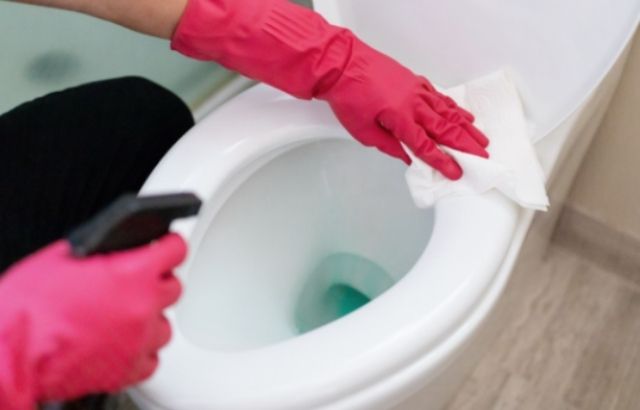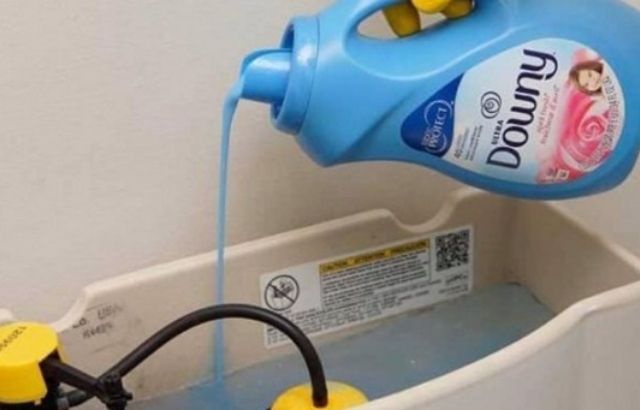How to Get Rid of Black Stains in Toilet

How do you Remove Black Spots in Toilet Bowl? | Cleaning Guide
Well! When it comes to cleaning bathrooms, it is essential to clean the toilet bowls very carefully, which is overlooked most of the time. Black spots you see in your toilet bowl are probably either mineral deposits or mold growth. If you don't use the toilet bowl very often, or if the stains are above the waterline, they can be of mold. On the other hand, if the marks are at or below the waterline or your house has a hard water supply, it is due to manganese formation. And if you are not sure about the spots that which type of stains you have, you should consider them as mold. If the trick for mold does not remove spots, continue the process of removing manganese. This article will give you some necessary tips on how do you remove black spots in a toilet bowl.
How do you Remove Black Spots in Toilet Bowl: Things you need
- Borax
- Distilled white vinegar
- Spray bottle
- Toilet brush
- Cup
- 3 % of hydrogen peroxide
- Cream of tartar
- Toothbrush
How do you Remove Black Spots in Toilet Bowl?
Mold spots
- To remove the stubborn stains from a toilet bowl, flush the toilet, as the bowl's sides are deep from the flush, so sprinkle borax into the black spots. Now pour the distilled white vinegar into the spray bottle, and spray it on the black stuff at the toilet bowl's bottom.
- Let the vinegar and borax mixture sits for a few hours in the bowl, and don't use the toilet. Scrub the black spots with a damp toilet brush to get rid of black stains in the toilet bowl. To give a clean finish to the bathroom, flush the toilet bowl in the end.
- Alternatively, you can also opt for distilled white vinegar and 3% cream of tartar poured in a toilet spray bottle to clean black spots.
Manganese spots
- If you have black stains at or above the water level, you should turn off the water source. Flushing the toilet to lower the waterline until you reaches the spots in the toilet bowl.
- To remove black spots in the toilet bowl at the waterline, make a paste by mixing cream of tartar and 3 % hydrogen peroxide. Put the paste on the old toothbrush to remove water toilet stains.
- You can also get rid of black spots with this paste if you let them sit on sites for 15 minutes. Use the water settled in the bowl and the bottle toilet brush to rinse the spots if you don't have to plan for draining.
- And if you want to empty the bowl, fill a cup of water, pour over the stains, and softly scrub with the help of a brush. Test the toilet bowl; if the stains remain the same, repeat this process and give it a long time for the paste to set on spots. And if the stains have gone, rinse the toilet bowl with clean water.
- Therefore inspect for the type of cleaning, and mark the schedule on the calendar so that you should keep this on the top of the list. Keeping a record of the schedule will help you call for the cleaning service as and when required.

Precaution:
- Borax is gentle on your pipes to clean your toilet bowl spots compared to acids and less harmful than bleach.
Warning:
- While removing stains and mold above the waterline, wear a dust mask.
How to Remove Calcification from Toilet bowls
- In your toilet bowls, the white or rust-colored spots are due to the build-up of minerals, like calcium and magnesium, in the water source.
- This is because hard water contains such types of minerals the most can damage your plumbing, and the calcium it leaves in your toilet bowl gathers and becomes very ugly. Learn how to repair water-damaged wall studs.
- These deposits become very stubborn and problematic with time, so it will be better for you to clean them as soon as possible because it will make your task easy.
- Turn off the water source and flush the toilet to lower the water level to expose the calcification.
- You should see underwater to examine the deposits; if they are still there, force more water down the toilet bowl for well-draining until all the deposits go into the air.
- Fill a toilet spray bottle with the distilled white vinegar, spray the solution freely on the rust spots. The vinegar should sit on the sites for at least 30 minutes.
- With the stiff-bristled nylon toilet brush, scrub the calcification; if it removes the stains, flush the toilet to rinse it water to drain out the vinegar. On the other hand, if scrubbing is not done, repeat this process to increase the sink's brush.
- Moreover, you can remove the black spots by pouring baking soda on the toilet brush. Scrub the calcification with the baking soda on the toilet bowl. If this process works well for removing stains, flush the water in the bowl to remove the residue. You can easily remove rust from the bottom of the toilet bowl by this process.

Precaution:
- The products used on a commercial basis contain diluted hydrochloric acid to remove calcification. If you opt for these chemicals, follow the instructions written on them.
- For ventilation, open the windows, and wear protective gloves and goggles too. Be quick in flushing the toilet bowl, as these chemicals have very poisonous fumes in them.
Warning:
- It would help if you did not blend the commercial cleaners that contain diluted hydrochloric acid with the products containing bleach.
- Before you start to clean your toilet bowl with acidic products, use the bleach to clean it two times regularly.
How to Clean Toilet Tank
- If you have got the bathroom shine last time by the concentrated effort to get rid of brown rust spots from the rim of your bowl of the toilet, your job may not be completed.
- Don't hit yourself for missing a site because it is often overlooked in the toilet tank. Its lid contains bacterial contamination and mineral build-up, too, until you lift them to stop the toilet tank for further repair.
- You can increase the life of your toilet tank and all of its other parts by cleaning it regularly twice a year, can fresh your bathroom smell, and can protect yourself from elbow grease.
You can clean the toilet tank by adopting one of the following methods.
- Empty the toilet tank by locating the shut-off valve. Open the lid and notice the water level in it.
- Access the position of grime and dirt in it and opt for the simple method to clean it.
- If you see the mineral deposits at the bottom of the tank, and the residue on the walls, use vinegar to solve it.
- Use the cups of vinegar to fill the toilet tank up to the overflow valve, but the quantity of vinegar used depends on the tank's size.
- Let it be set on the toilet tank for 12 hours without flushing it.
- When you see that it is ready to clean, flush it out for vinegar removal.
- Wear rubber gloves and spray the disinfectant cleaner on the toilet tank walls and its bottom.
- Avoid spraying it on the metal parts of bathrooms to avoid corrosion additives that can react with the metal.
- Use a new, long narrow scrub brush to clean the tank's inner side to remove all the grime and mineral build-up.
- Applying additional cleaners is necessary; if you see that your toilet parts need to be replaced, it is the right time to do the job.
- Now turn the water back in its position to fill the tank, and flush it thrice.
- When you are happy with your tank's sparkling clean, turn the valve on to fill it for further use.

How do you Remove Black Spots in Toilet Bowl: FAQs
How to remove water spots from ceramic tiles?
To remove water spots from ceramic tiles, make a mixture of white vinegar with water or baking soda, as the acid in it helps to break mineral deposits formed due to hard water. Learn How To Waterproof A Shower Without Removing Tiles.
What causes the black stains in my water bowl and tank?
The black spots in your water tank and bowl are due to the pipe corrosions after many years of use.
What causes stubborn toilet bowl stains?
The toilet bowl stains are due to the hard water, as it is rich in minerals and calcium, which gathers over time and can be seen inside the toilet bowl.
Conclusion
To end the topic,how do you remove black spots in a toilet bowl? The above tips and precautions will be constructive for removing grime, dirt, and mineral deposits. You might hear a suggestion to clean regiment for toilet bowls and tanks, but in my opinion, twice-yearly will be reason enough to do the job. But the maintenance is a must in every aspect, especially when 85 % of the households are dealing with hard water. If your toilet is located in a high traffic area and is in much use, regular cleaning is essential.

Betty W. Lyons is the Co-Founder, Content Writer & Researcher of Home Affluence. Betty W. Lyons is a crazy toad lady from the Bronx who was exiled to New Jersey, spending a significant chunk of her youth where all the hideous 1970s couch covers and avocado shag carpeting went to die.
Betty graduated with a Bachelor of Science (B.S.) in interior design from the New York School of Interior Design (Lincoln) in 2013. Betty is also expertise in Gardening and Plants. She got her master's degree in Horticulture from the University of Edinburgh – MSc Sustainable Plant Health, Biodiversity, and Taxonomy of Plants.
She is an expert in In Garden Design, Plant selection, plant knowledge, garden maintenance, pest control, the solution to difficult garden, Vegetable, and Herb Gardens, Garden business, and many more.
She has held multiple professional interior design positions since 2013 that involved conceptual design and execution with several leading design software tools and platforms.
At Home Affluence, Betty covers the below topicsof Garage, Gardens & Landscaping, Gutters, Roofing, Siding, Windows, Plants, Kitchen, Bathroom, Dining Room, Bedrooms, and Kid's Room.
How to Get Rid of Black Stains in Toilet
Source: https://homeaffluence.com/how-do-you-remove-black-spots-in-a-toilet-bowl/
Comments are closed.